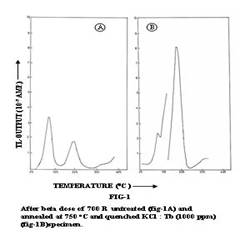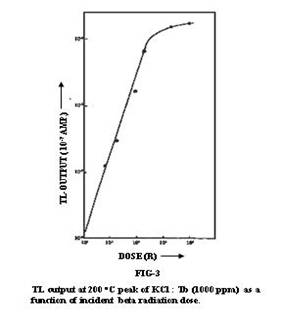
Thermoluminescence Study of kcl:Tb(T) Phosphor for Beta Radiation Dosimetric Application
AbstractThe present work involves extensive study of thermoluminescent behaviour of untreated and thermally pre-treated, Tb doped KCl phosphors. It is found that KCl:Tb ( 1000 ppm of terbium concentration) specimens, quenched from 750 oC designated as KCl:Tb (T), display optimum TL output with a dominant and well defined glow peak around 200 oC. The study of this peak for beta radiation dosimetry indicated that the KCl:Tb phosphor satisfied most of the basic requirements of an efficient TLD material. It is suggested that the present material can be used in beta dosimetry for the range 10o – 104 rad.
Keywords:Thermoluminescence,TL,Dosimetry,Kcl:Tb
The heart of the solid state TL dosimeter is the luminescent material. Many phosphors, like LiF,CaSo4,CaF2 and CaSo4:Dy have been examined for their use in dose estimations [1-3].Survey of the literature shows that alkali halide phosphors with trivalent impurity have so far not been studied for their dosimetric properties . In the present work experiments were conducted using potassium chloride as base material with terbium as the impurity to examine the utility of the phosphor in dosimetry.
1.EXPERIMENTALThe polycrystalline specimen of KCl:Tb (1000 ppm ) was prepared by the method of crystallization from aqueous solution. The specimen thus obtained was annealed at 750 oC for two hours and subsequently quenched to room temperature in air. The TL characteristics of specimen were examined for the temperature range of 25-450 oC , by heating the phosphor at a rate of 200 oC/min. The TL output was measured by conventional method. The source of radiation used in the present work was Sr90 beta sourced
1.1.RESULTS AND DISCUSSIONSFig-1A and 1B show typical TL glow curves of untreated and annealed 750 oC and quenched KCl:Tb (1000 ppm ) specimens .The specimens is exposed to beta radiation. It is seen that from Fig-1A that untreated specimen exhibits dominant glow peak at 100 oC while a peak appear around 200 oC in the case of thermally treated specimen Fig-1B. This specimen, KCl:Tb (T) exhibits a well defined peak at 200 oC.
The TL glow curves display by KCl:Tb(T) specimen after exciting them with different doses of beta radiation are presented in Fig-2 .The data indicate that there is consistent growth of 200 oC peak increase in beta dose. The occurrence of 200 oC glow peak at relatively higher temperature and its systematic growth with the increase in radiation dose was important factors in examining this peak from dosimetry aspect.
Fig-3 show the intensity of 200 oC glow peak as a function of the dose of beta radiation in the case of KCl:Tb(T) phosphor. The result obtained show straight line superlinear relation between incident radiation dose and TL output of at 200 oC peak.


The appearance of well resolved 200 oC peak in the glow curve clearly indicates that the trap is single valued and that a large number of them are involved in the generation of the peak 200 oC . This is a basic requirement for a good TLD material. The 200 oC peak being on the higher side temperature scale, deeper traps are involved in the TL process. This leads to the long storage of trapped electrons at the normal working temperature. Further more. It is observed that the position of the 200 oC peak does not shift with the increase in the radiation dose. It is therefore, inferred that the material under investigation is resistive to radiation damage.
CONCLUSIONThe KCl:Tb(T) phosphor satisfied the most of basic requirements, which enhance the claim of KCl:Tb (T) for use as TLD material in beta dosimetry.
REFERENCES :
***************************************************
A. N. SAYANI
College of Fisheries, J.A.U ,Veraval
M.M.Science College, Morbi
R. U. PUROHIT
Joint Director ,Commissioner of Higher Edu., Gandhinagar
K.V.R.Murthy
Applied Phy.Dept.M.S.Uni.,Baroda



Home | Archive | Advisory Committee | Contact us